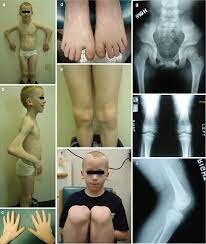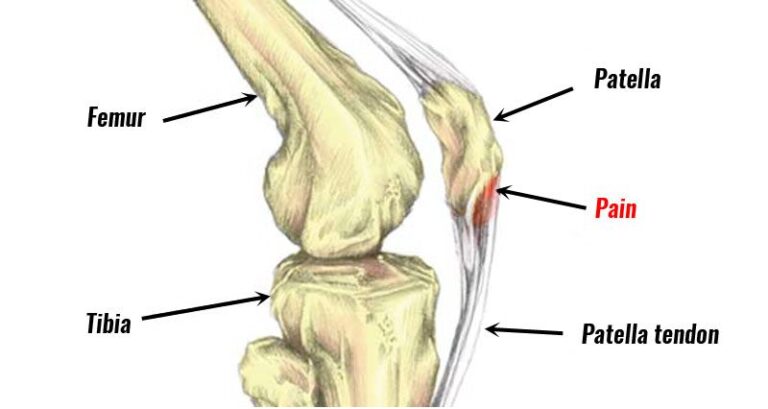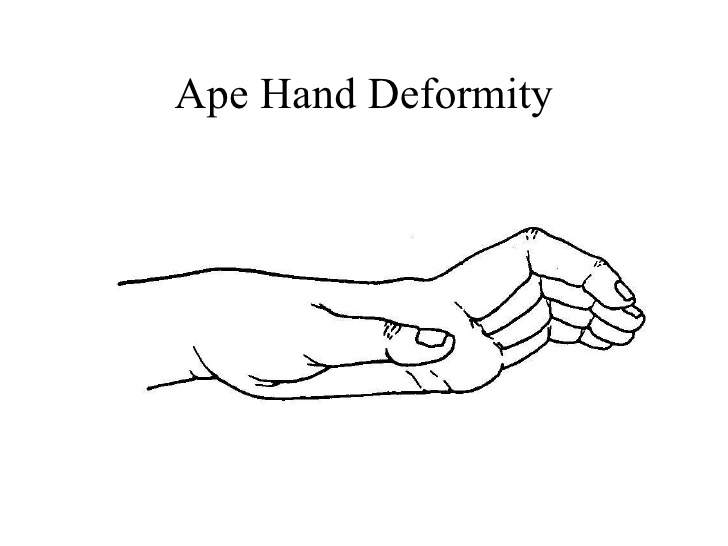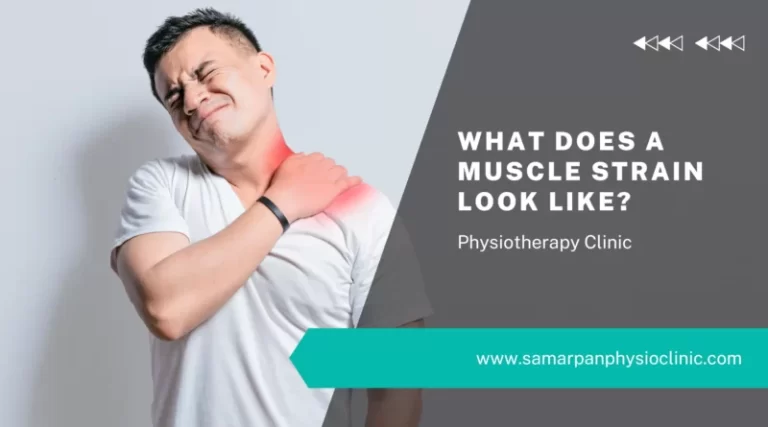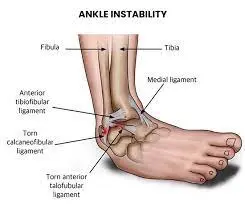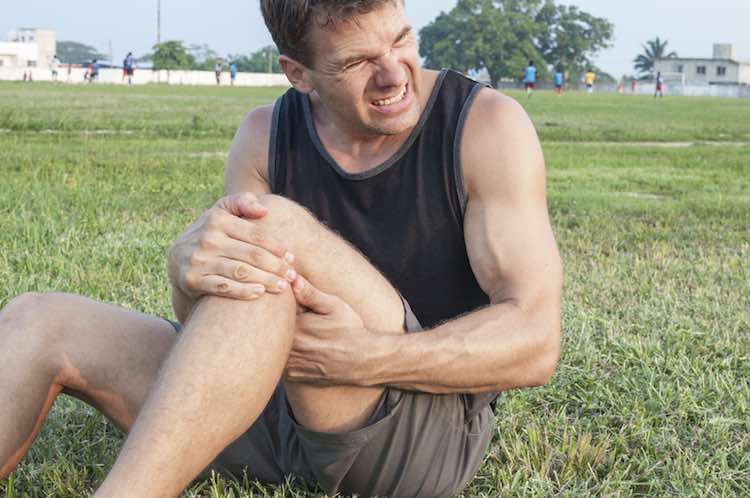Nail patella syndrome
Nail patella syndrome is a rare genetic condition that may cause problems with the nails, bones, and kidneys.
Table of Contents
Symptoms of nail-patella syndrome
Almost every people with nail-patella syndrome has abnormal nails, and so many people also have problems with their kneecaps (patellae), elbows, and pelvis. Some of the problems will be obvious from birth, but others can not become apparent until later on. There are several symptoms and problems connected with nail-patella syndrome.
Nails
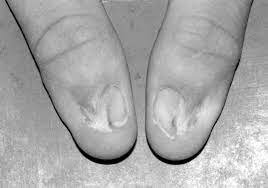
- Nails can be missing, underdeveloped, discolored, split, ridged, or pitted.
- Thumbnails are most severely affected, with each fingernail being less affected from the index finger to the little finger.
- Toenails are generally less affected by the condition.
Kneecaps
- The kneecaps can be missing, small, irregularly shaped, and easily dislocated, and may click, lock, or can feel unstable or painful.
Arms and elbows
- Some individuals are unable to fully extend their arms or turn their palms up while keeping their elbows straight.
- The elbows can also, angle outwards, and dislocations may happen.
Pelvis
- Bony growths on the pelvic bone (visible on X-rays) are usual but do not generally cause problems.
Kidneys
- There can be protein in the urine (a primary sign of kidney problems), which may be consummated by blood in the urine.
- This may sometimes progress to kidney disease.
Other possible symptoms involve
- Underdeveloped shoulder blades
- Scoliosis, which is a c shape curve in the spine
- Glaucoma
- Cataracts
- Color changes of the iris
- Unusually small corneas
- kidney problems.
Causes of Nail-patella syndrome
- Nail patella syndrome is generally caused by a fault in a gene called LMX1B that is inherited from one parent.
- But there is not always a family history of nail-patella syndrome.
- In a few cases, an LMX1B gene mutation (alteration) takes place for the first time on its own.
Diagnosis
Diagnosis may occur at birth, in early childhood, or later in life. To diagnose the condition, an examiner or Doctor will require to:
- Identify certain characteristic findings, like atypical nails, kneecaps, or elbows or the presence of iliac horns.
- Do a thorough clinical investigation into symptoms.
- Take a personal and family medical history.
- Order advanced imaging techniques.
- Order laboratory testing.
- Imaging technologies like X-rays and CT scans can help a doctor identify bone and joint irregularities.
Nail patella syndrome is generally diagnosed based on a person or person’s child’s symptoms. In most cases, a blood test to check
Genetic testing
- The faulty gene may confirm the diagnosis.
- In about 5% of individuals diagnosed with nail-patella syndrome, a fault in the LMX1 B gene may not be found.
Having children
- If the person has the nail-patella syndrome, there is a 1 in 2 (50%) chance that any baby you have will be born with the condition.
- If a person is planning to have a baby, talk to your general physician about getting a referral to a genetic counselor.
- They may explain the risks and what your options are. These can involve:
Having tested at the time of pregnancy to see if the baby will be born with nail-patella syndrome Trying pre-implantation genetic diagnosis (PGD)
PGD is equivalent to in vitro fertilization (IVF), but the embryos are tested to check that they do not have the faulty gene before they are implanted in the womb.
Other tests
- A dental examination should be searched out at least every 6 months.
- An assessment of bone density is suggested for young adults to check for osteoporosis.
Other Names of Nail patella syndrome
- Fong disease
- Hereditary onycho-osteodysplasia
- Hereditary osteo-onychodysplasia
- Osterreicher syndrome
- Pelvic horn syndrome
- Turner-Kieser syndrome.
Treatments for Nail-patella syndrome
- There is no cure for nail-patella syndrome, but treatments are available to help manage the symptoms.
- Symptomatic Medical treatment with Physical therapy treatment/exercise may help some extent.
Kneecap and joint problems
If the kneecaps are easily dislocated and painful, painkillers, physiotherapy, splinting, and bracing can help.
But the long-term use of non-steroidal anti-inflammatory drugs (NSAIDs) should be kept away because they may affect the kidneys. Some people can require corrective surgery for problems with the bones and joints. This should be found out after an MRI scan by a surgeon who understands the condition. Here is some kneecap management exercise to reduce the symptoms.
Static Quad

- Begin on the non-involved leg.
- Pull the toes up towards your shin, and push the knee into the bed to tighten the quad muscles.
- This should cause the heel to slightly lift off the bed.
- Hold for 10 seconds. Repeat on the involved leg.
Knee Extension over Roll

- Position the knee over a rolled-up towel as shown.
- Pull the toes up towards the shin and entirely straighten the knee.
- Hold for 10 seconds.
- Return to the initial position and repeat.
Vmo stage 1 – Sitting
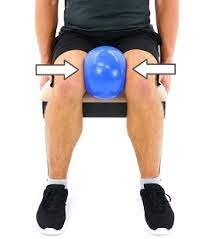
- Starting with sitting in a comfortable position in a chair, feet hip-width apart with a soft football in between the knees.
- Start to clench the buttocks, clench the knees and gently squeeze the ball with the knees.
- Hold for 10 secs and relax.
- Repeat it 10 times.
- When a person squeezes the ball, make sure the squeezing movement comes from the knees, not from the hips
VMO Stage 2 – Lying
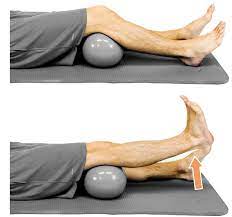
- Start with lying on the back with a pillow under the knees.
- Feet hip-width apart with a soft football in between the knees.
- Start to clench the buttocks, clench the knees and slowly squeeze the ball with your knees.
- Hold for 10 secs and relax.
- Do it a further 10 times with a 10-second hold.
- Ensure that a person keeps squeezing the ball throughout knee cap exercises – keep the knee and buttock clench going throughout.
- Keep up the knee resting on the pillow – do not lift it up
Vmo stage 3 – Standing
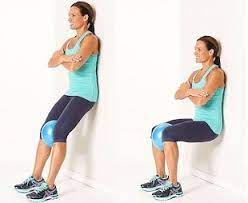
- Start with a standing position with the back against the wall, feet hip-width apart about 10cm away from the wall.
- Put a soft football in between the knees.
- Squeeze the ball as with as similar to stage one and two (clench knees and buttocks) and then gently squat down as far as comfortable.
- Hold for ten secs and return back up.
- Do ten repetitions.
Leg lifts
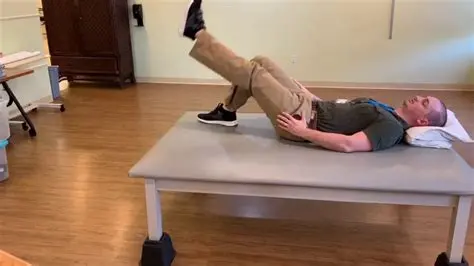
- Start with lying down on the floor with the back flat. Utilize a yoga mat, folded blanket, or exercise mat for comfort on a hard floor.
- Keep up the left leg straight and bend the right leg slightly at the knee, just take the foot closer to the body.
- Pull the abdominal muscles inward by thinking of the belly button pulling down toward the floor.
- Performing this should bring the lower back down against the floor and help to give extra support at the time of the exercise.
- Put a hand under the lower back to make sure that there is no space between the small of the back and the floor.
- If there is space for the hand, slowly push the lower back down on top of the hand.
- Gently lift the left leg without bending the knee.
- Maintain the toes pointed toward the ceiling and stop when the leg is about 10 inches off the floor.
- It should not be greater than the bent knee on the right leg.
- Hold the left leg up for five to 10 seconds.
- Gently lower the leg back down to the floor.
- Do not put it down too rapidly or let it drop.
- Repeat five more times with the same leg.
- Change the sides and repeat it.
Hamstring curls on a weight bench
This exercise is a modification of the standing hamstring curl. An individual may try this version if they have access to a weight bench that is purpose-built for this exercise. It can be more challenging than the standing hamstring curl, depending on how much weight an individual uses.

- Start with lying face down on the bench with the knees close together.
- Grasp the handles for stability.
- Tuck the feet beneath the weight.
- The weight should sit just on the upper side of the heels.
- Gently bend both knees, using the force of the legs to raise the weight up.
- Carry on to lift the weight in a very gentle motion until the knees bend at a 90-degree angle.
- Hold the weight up for 10 seconds and then gently lower it back down.
- Do it 5-10 times.
Step exercises

- Utilize a large, sturdy stool or exercise platform no taller than 6 inches.
- Step up onto the stool with the involved foot and allow the noninvolved foot to follow behind.
- The non-involved foot should not be on the stool but should hang behind it.
- Keep up the body weight on the involved foot and hold for up to 10 seconds.
- Gently lower the left foot down and then follow it with the right foot.
- Change the legs, stepping up with the opposite foot first.
- Repeat it ten times.
Double Knee To Chest
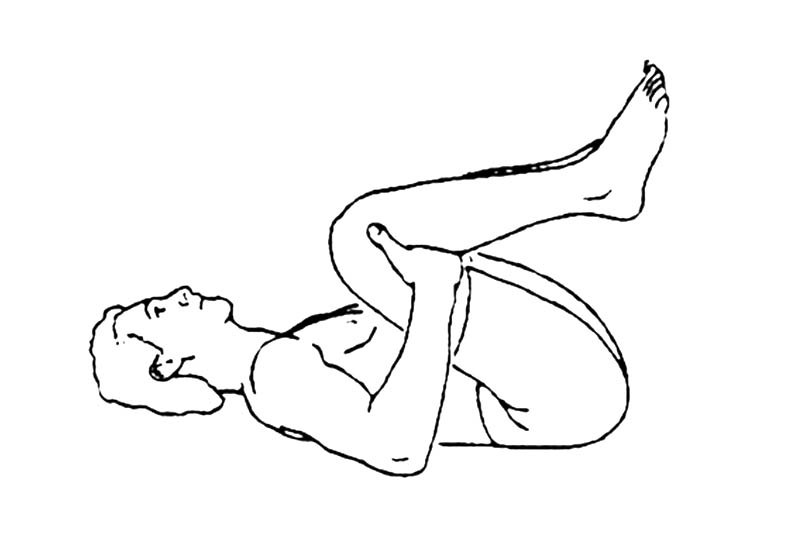
- Start on the back with the legs outstretched.
- Take both knees up together and place the hands below the knee area on the top of the shin.
- An alternative place for the hands is the back of the thighs.
- Gently bring the knees toward the chest, hold for five to ten seconds, then go back to the initial position.
Stretching exercises
- According to the American Academy of Orthopaedic Surgeons, performing lower body stretching exercises can help to increase the range of motion and flexibility in the knee joint.
- This may make it easier to move the knee.
- Prior to starting stretching, it is necessary to spend at least 10 to 15 minutes warming up.
- Low-impact activities such as cycling on a stationary bike, walking, or using an elliptical machine are good warmup options.
- Once a person warmed up, do the given three stretches, and then repeat them once a person completed the knee-strengthening exercises.
- Try to perform these stretches and exercises at least 5 to 7 times a week.
Heel and calf stretch
This stretch targets the muscles in the lower leg, specifically the calf muscles. To perform this stretch:
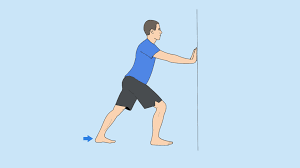
- Start with standing facing a wall.
- Place the hands on the wall and move one foot back as far as a person may comfortably.
- Toes on both feet should be facing forward, heels flat, with a slight bend in the knees.
- Lean into the stretch and hold for 20 – 30 seconds.
- The person should experience the stretch in the back leg.
- Switch legs and repeat.
- Perform this stretch thrice for both legs.
Quadriceps stretch
This stretch especially targets the quadriceps, the muscles at the front of the thighs. Doing this move may help to increase the flexibility in the hip flexors and quadricep muscles. To perform this stretch:
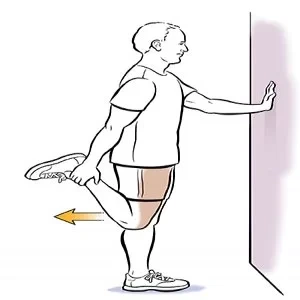
- Start with standing next to a wall or use a chair for support.
- The feet should be shoulder-width apart.
- Bend one knee so the foot goes up toward the glutes.
- Grasp the ankle and slowly pull it toward the glutes as far as a person may comfortably.
- Hold for 20 to 30 seconds.
- Return to the initial position and switch the legs.
- Repeat thrice times on each side.
Hamstring stretch
This stretch targets the hamstrings, and the muscles in the back of the thigh. A person should experience this stretch in the back of the leg and up to the base of the glutes. If a person flexes the foot, the person can also feel the stretch in the calves. To perform this stretch:
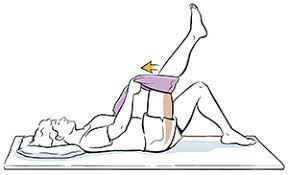
- For this stretch, a person may use a mat to add cushioning under the back.
- Start with lying down on the floor or mat and straightening both legs. Or, if it is more comfortable, a person may bend both knees with the feet flat on the floor.
- Lift one leg off the floor.
- Place the hands behind the thigh, but below the knee, and slowly pull the knee toward the chest until a person experiences a slight stretch.
- This should not be painful.
- Hold for 20 to 30 seconds.
- Lower and switch the legs.
- Repeat thrice times on each side.
Strengthening exercises
According to the American Academy of Orthopaedic Surgeons, a person may help to decrease the stress on the knee joint by regularly working the muscles around the knee. To help strengthen the knees, focus on moves that work on the hamstrings, quadriceps, glutes, and hip muscles.
Half squat
Half squats are a great method to strengthen the quadriceps, glutes, and hamstrings without straining the knees. To perform this exercise:

- Get into a standing squat position with the feet shoulder-width apart.
- Place the hands on the hips or out in front of you for balance.
- Looking straight ahead, gently squat down about ten inches.
- This is the halfway point to a full squat.
- Stop for a few seconds, then stand up by pushing through the heels.
- Do 3 to 5 sets of ten repetitions.
Calf raises
This exercise strengthens the back of the lower legs, which includes the calf muscles. To perform this exercise:
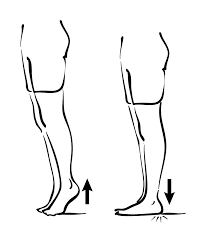
- Start with standing the feet shoulder-width apart.
- Position yourself next to a wall or hold on to the back of a chair for support.
- Lift both heels off the ground so that a person is standing on the balls of the feet.
- Gently lower the heels to the starting position.
- Control is necessary with this exercise for strengthening the calf muscles.
- Perform 3 to 5 sets of ten repetitions.
Hamstring curl
The standing hamstring curl targets the hamstrings and glutes. It also needs good core strength to keep the upper body and hips steady. To perform this exercise:

- Start with a stand facing a wall or use a chair for support.
- The feet should be hip-width apart.
- Lift one foot up, bend the knee, and raise the heel toward the ceiling.
- Go as far as a person can, while keeping the upper body still and hips pointing forward.
- Hold for 10 to 15 seconds.
- Relax and lower to the initial position.
- Perform 3 to 5 sets of ten repetitions for each leg.
Leg extensions
Using the own body weight, rather than a weighted machine, to strengthen the quadriceps helps keep added pressure off the knees. To perform this exercise:

- Sit up tall in a chair.
- Place the feet flat on the floor, hip-width apart.
- Look straight ahead, contract the thigh muscles, and extend one leg as high as possible without raising the buttocks off the chair.
- Stop, then lower to the initial position.
- Perform 3 to 5 sets of ten repetitions for each leg.
Straight leg raises
The straight leg raise strengthens the quadriceps as well as the hip flexor muscles. If a person flexes the foot at the end of the move, you should also experience the shins tightening. As this exercise gets easier to perform, a person may add a five-pound ankle weight and slowly work up to a heavier weight as you build strength in the legs. To perform this exercise:

- For this exercise, a person can use a mat to add cushioning under the back.
- Start with lying down on the floor with one leg bent and one leg straight out in front of you.
- Contract the quadricep of the straight leg and gently raise it up off the floor until it is the same height as the bent knee.
- Stop at the top for 10 seconds, then lower to the initial position
- Do 3 to 5 sets of ten repetitions for each leg.
Side leg raises
This exercise works on the hip abductor muscles as well as the glutes. The hip abductor muscles, situated on the outside of the hips, help a person to stand, walk and rotate the legs with ease. Strengthening these muscles may help prevent and treat pain in the hips and knees. As this exercise gets easier to perform, a person may add a five-pound ankle weight and slowly work up to a heavier weight as you build strength in the leg muscles. To perform this exercise:
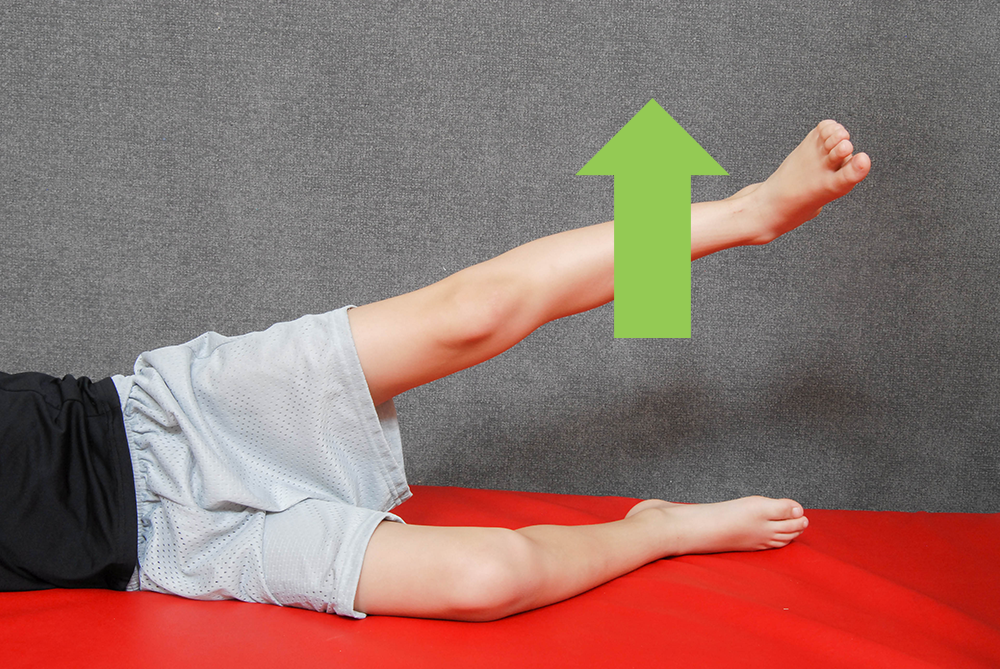
- Start with lying on the side with the legs stacked on top of each other.
- Cradle the head in one hand, and place the other hand on the floor in front of you.
- Lift up the top leg as high as a person comfortably may.
- A performer should experience this on the side of the hips.
- Stop briefly at the top, then lower the leg.
- Do 3 to 5 sets of ten repetitions for each leg.
Prone leg raises
This exercise works on the hamstrings as well as on the glutes. As this exercise gets easier to perform, a person may add a five-pound ankle weight and slowly work up to a heavier weight as you build strength in the leg muscles. To perform this exercise:

- For this exercise, a person may use a mat to add cushioning beneath her.
- Start with lying on your stomach with your legs straight out behind you.
- A person may let the head rest on the arms.
- Engage the glute and hamstring muscles in the left leg and lift your leg as high as you comfortably may without causing pain.
- Make sure to keep up the pelvic bones on the floor throughout this exercise.
- Hold the leg in the lifted position for ten seconds.
- Lower the leg, rest for two seconds, then repeat.
- Do 3 to 5 sets of ten repetitions for each leg.
Other types of exercise for knee pain
- Once a person had built up strength in the knees, person can want to consider adding low-impact exercises to the routine.
- Low-impact exercises typically put less stress on the joints than high-impact exercises, like running or jumping.
Some good examples of low-impact exercises include
- Yoga
- Tai chi
- Elliptical machine
- Swimming
- Stationary cycling
- Water aerobics
- Walking.
Treatment for kidney problems
- Urine tests should be researched at birth to check for kidney problems.
- High levels of protein in the urine can need to be treated with medication.
- After some time, the urine and blood pressure should be tested every year.
- Kidney problems can happen at the time of (or be made worse by) pregnancy in women who have nail patella syndrome.
- It is suggested that pregnant women with the condition have their blood pressure taken and urine tested very often.
- If the kidneys are not working properly, a person can need dialysis, where a machine is used to replicate many of the kidney’s functions.
- If the person has severe kidney disease, the person can require a kidney transplant.
Treatment for glaucoma
- Screening for glaucoma should begin as soon as a baby is able to cooperate with the examination.
- Treatment for glaucoma can include using eye drops or having a procedure to decrease the pressure inside the eye.
- Read more about testing for glaucoma and treating glaucoma.
FAQ
Each child of an individual with an autosomal dominant disease has a fifty percent (1 in 2) chance of inheriting the variant and the disease. Typically, children who inherit a dominant variant will have the disease, but they can be more or less severely impacted than their parents.
The prevalence of nail-patella syndrome is approximated to be 1 in 50,000 individuals.
Usually, with appropriate patellar tendonitis treatment, an injury may be resolved in about 6 weeks. However, full recovery may take weeks to months after physical therapy. Knee pain can subside in about three weeks, but full recovery will be noticeable in six weeks.
Nail-patella syndrome (NPS) is a multisystemic disorder distinguished by significant inter- and intrafamilial variability in clinical manifestations and severity of the disease. Cases may range from mild with no functional impact to severe leading to disability.
There is no cure for nail-patella syndrome, but treatments are available to help manage the symptoms.

